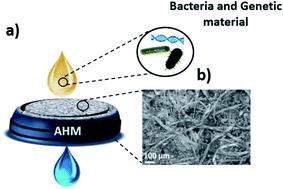当前位置:
X-MOL 学术
›
Nanoscale Adv.
›
论文详情
Our official English website, www.x-mol.net, welcomes your feedback! (Note: you will need to create a separate account there.)
Amyloid hybrid membranes for bacterial & genetic material removal from water and their anti-biofouling properties
Nanoscale Advances ( IF 4.7 ) Pub Date : 2020-09-11 , DOI: 10.1039/d0na00189a Archana Palika 1 , Akram Rahimi 1 , Sreenath Bolisetty 1, 2 , Stephan Handschin 1 , Peter Fischer 1 , Raffaele Mezzenga 1, 3
Nanoscale Advances ( IF 4.7 ) Pub Date : 2020-09-11 , DOI: 10.1039/d0na00189a Archana Palika 1 , Akram Rahimi 1 , Sreenath Bolisetty 1, 2 , Stephan Handschin 1 , Peter Fischer 1 , Raffaele Mezzenga 1, 3
Affiliation

|
Water scarcity and contamination by biological pollutants are global challenges that significantly affect public health. Reverse osmosis, nanofiltration and ultrafiltration technologies are very effective for the elimination of pathogens and most contaminants but associated with considerable capital and operating costs, high energy consumption and the use of chlorinated chemicals to suppress membrane fouling. Additionally, the pressure needed by these techniques may disrupt the pathogenic microbial cell membranes, causing the release of genetic material (fragments of DNA, RNA and plasmids) into the water. Here, we introduce the simultaneous removal of both bacteria and associated genetic material using amyloid hybrid membranes, via a combined adsorption and size exclusion mechanism. Amyloid hybrid membranes can remove upto and beyond 99% of the genetic material by adsorption, where amyloid fibrils act as the primary adsorbing material. When the same membranes are surface-modified using chitosan, the anti-biofouling performance of the membranes improved significantly, with a bacterial removal efficiency exceeding 6 log.
中文翻译:

用于从水中去除细菌和遗传物质的淀粉样蛋白杂化膜及其抗生物污染特性
水资源短缺和生物污染物污染是严重影响公众健康的全球性挑战。反渗透、纳滤和超滤技术对于消除病原体和大多数污染物非常有效,但与相当大的资本和运营成本、高能耗以及使用氯化化学品来抑制膜污染相关。此外,这些技术所需的压力可能会破坏致病微生物的细胞膜,导致遗传物质(DNA、RNA 和质粒片段)释放到水中。在这里,我们介绍了使用淀粉样蛋白杂化膜,通过吸附和尺寸排除相结合的机制,同时去除细菌和相关遗传物质。淀粉样蛋白杂化膜可以通过吸附去除高达 99% 的遗传物质,其中淀粉样蛋白原纤维充当主要吸附材料。当使用壳聚糖对同一膜进行表面修饰时,膜的抗生物污染性能显着提高,细菌去除效率超过6 log。
更新日期:2020-10-13
中文翻译:

用于从水中去除细菌和遗传物质的淀粉样蛋白杂化膜及其抗生物污染特性
水资源短缺和生物污染物污染是严重影响公众健康的全球性挑战。反渗透、纳滤和超滤技术对于消除病原体和大多数污染物非常有效,但与相当大的资本和运营成本、高能耗以及使用氯化化学品来抑制膜污染相关。此外,这些技术所需的压力可能会破坏致病微生物的细胞膜,导致遗传物质(DNA、RNA 和质粒片段)释放到水中。在这里,我们介绍了使用淀粉样蛋白杂化膜,通过吸附和尺寸排除相结合的机制,同时去除细菌和相关遗传物质。淀粉样蛋白杂化膜可以通过吸附去除高达 99% 的遗传物质,其中淀粉样蛋白原纤维充当主要吸附材料。当使用壳聚糖对同一膜进行表面修饰时,膜的抗生物污染性能显着提高,细菌去除效率超过6 log。



























 京公网安备 11010802027423号
京公网安备 11010802027423号